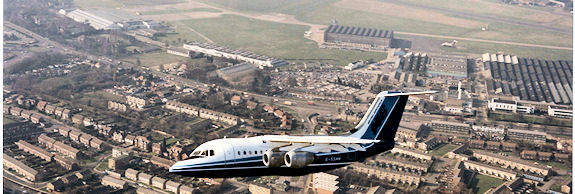
Hatfield Aerodrome was an airfield and aircraft factory located in the town of Hatfield, Hertfordshire from 1930 until its closure and redevelopment in the 1990s.
Geoffrey de Havilland, pioneering aircraft designer and founder of the de Havilland Aircraft Company purchased some farmland close to Hatfield as his existing site at Stag Lane, Edgware was being encroached upon by expanding housing developments in the London suburbs. Flying commenced in 1930, but the clubhouse buildings and adjacent recreational facilities, fuel pumps and sheds were not completed until 1933.
In 1934 significant works were undertaken at the site and a large factory and imposing Art Deco administration buildings were constructed together with a flying school building which also housed flying control. Later, an experimental block was added to the north of the factory. Production of aircraft, moved from Stag Lane and during this time principally consisted of a range of small biplanes such as the Moth family, DH.84 Dragon, DH.86 Express and DH.89 Dragon Rapide.
During the Second World War, de Havilland produced a number of aircraft, notably the wooden construction de Havilland Mosquito fighter bomber. Development took place at nearby Salisbury Hall to avoid being targeted by German bombers. The Hatfield site itself was camouflaged but was bombed on 3 October 1940 by a Junkers Ju 88. Four bombs hit the '94 shop' building, killing 21, injuring 70 and disrupting work on the Mosquito.
A hard runway was laid in 1947, as the facilities were expanded with the rapid development of military and civil jet aircraft such as the Vampire, Venom and Comet. The factory was enlarged and a new flight test hangar and control tower was constructed. Additionally, a large design block was constructed adjacent to the administration buildings.
The company continued to develop jet engines, rockets, guided missiles and Britain's ballistic missile, the Blue Streak. Missile production facilities, test facilities, wind tunnels, water tanks, hangars and an administration building were located on the Manor Road site, on the opposite side of the main runway to the aircraft factories. jet engine production was nearby at Leavesden.
With the consolidation of the British aircraft industry forced by government, the de Havilland Aircraft Company was acquired by Hawker Siddeley in 1960 and the de Havilland name ceased to be used in 1963. At Hatfield, the Trident airliner and DH.125 were under development in the early 60s, with production of the later taking place at de Havilland's other factory at Hawarden. Design studies for feederliners that would ultimately lead to the HS.146 took place as well as studies for a pan-European aircraft, the HBN.100 which would eventually become the Airbus A300. Hatfield once again changed ownership when Hawker Siddeley was merged with the British Aircraft Corporation and Scottish Aviation under the Aircraft and Shipbuilding Industries Act to form British Aerospace in 1978. Hatfield became the centre of design and production of commercial aircraft for the next decade.
The 146 first flew in 1981 and production of some components, final assembly and flight testing of the first two series of the aircraft was based at Hatfield during the early and mid 1980s. In 1987, a new final assembly hall was built for 146 production to coincide with the introduction of the stretched 146-300 derivative. Further development resulted in the demolition of the original 1930s flying club buildings to make way for the Bishop Square office block development (named in honour of Comet designer R.E. Bishop). In 1992, due to severe financial problems, British Aerospace announced the cessation of aircraft production at Hatfield in 1993. By this point, work on the Manor Road site, which had become part of BAe Dynamics had wound down and this site was cleared first.
The redevelopment of the main airfield site commenced in the late 1990s. Only the listed flight test hangar and administration buildings were retained; all other buildings, taxiways and runway were removed to make way for new offices, businesses and homes. Today the flight test hangar survives as a leisure centre, whilst the rest of the site is divided between the University of Hertfordshire, housing and a business park.
The administration building is Liste Grade II listed and serves as part of the Hertfordhire Police HQ in Hatfield. The oval glazed part at the rear contains the cells. When built, the hangar was the largest aluminium building in the world.
By road: On A414

Beaver, Paul & Gander, Terry, Modern British Military Missiles, Patrick Stephens, ISBN-10: 0850598370 (1986)
Birtles, Philip, Hatfield Aerodrome - A History, British Aerospace, ISBN-10: 0952161303 (1993)
Davies, R. E. G. & Birtles, Philip, De Havilland Comet: The World's First Jet Airliner, Paladwr Press, ASIN: B0014GEYZ6 (1999)
Darling, Kevin, De Havilland Comet, Crowood Press, ISBN-10: 1861267339 (2005)
Graham-Cowell, J., De Havilland Comet: The World's First Jet Airliner, Mach III Plus, ISBN-10: 1898129444 (1999)
Gunston, Bill, Airbus: The Complete Story, J H Haynes & Co, ISBN-10: 1844255859 (2009)
Hardy, Michael, BAE 146, Ian Allan, ISBN-10: 0711020108 (1991)
Howe, Stuart, De Havilland Mosquito: An Illustrated History: Vol 1, Crecy Publishing, ISBN-10: 0947554769 (1998)
Jackson, Aubrey Joseph, De Havilland Aircraft Since 1909, Putnam Aeronautical, ISBN-10: 085177802X (1987)
Jones, Barry, De Havilland Twin-Boom Fighters: Vampire, Venom and Sea Vixen, Crowood Press, ISBN-10: 1861266812 (2004)
McKim, Frank, Trident: A History, The History Press, ISBN-10: 0752444026 (2008)
Phipp, Mike, The Brabazon Committee and Airliners 1945 - 1960, The History Press, ISBN-10: 0752443747 (2007)
Skinner, Stephen, BAe 146/RJ, The History Press, ISBN-10: 0752435620 (2005)
Skinner, Stephen, BAC One-Eleven: The Whole Story, The History Press, ISBN-10: 0752427741 (2002)
Skinner, Stephen, British Airliner Prototypes Since 1945, Midland Publishing, ISBN-10: 1857802993 (2008)
Stocker, Jeremy, Britain and Ballistic Missile Defence, 1942-2002, Routledge, ISBN-10: 0714656968 (2004)
Thirsk, Ian, De Havilland Mosquito: An Illustrated History: Vol 2, Crecy Publishing, ISBN-10: 0859791025 (2008)
UK Government, East of England: Case Study: Hatfield Aerodrome, Office of the Deputy Prime Minister, ASIN: B001PDIOFY (2005)